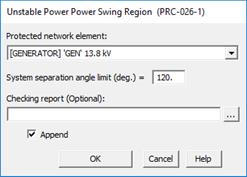
The Add | Unstable Power Swing Limit command in the OC Curves Window computes a current limit, according to the PRC-026-1 Standard, for a phase overcurrent relay.
Note: Voltage-restrained and voltage-controlled overcurrent relays are exempt from PRC-026-1 requirements.
The command draws a vertical line on the plot, at the value of the limit. See picture below. To comply with the Standard, the relay’s instantaneous setting, must stay outside of the rectangular region at the lower-left corner of the diagram.
This command can be applied to an overcurrent phase relay that protect a line, transformer or a generator.
To calculate the current limit for relay that protects a line or transformer, the entire network is reduced to a 2-bus equivalent that comprises of the end buses of (1) the line or 2-winding transformer, or (2) the primary and secondary terminal of a 3-winding transformer. To calculate the current limit for relay that protects a generator, the entire network is reduced to a single bus equivalent at the generator bus that comprises of the generator and the equivalent system source. The current limit is computed as the flow across the relay branch when (1) the voltage angle between the sending and receiving source is at the system separation angle limit, (2) the voltage at the terminal buses are at 1.05 pu, and (3) the transfer impedance of the 2-bus equivalent is ignored.
TO DISPLAY THE UNSTABLE POWER SWING CURRENT LIMIT:
1. Select the Add | Unstable Power Swing Limit command.

Note: This command is dimmed and cannot be execute if an unstable power swing limit is already being displayed. To add a new unstable power swing limit, you must first delete the existing one with the Delete | Unstable Power Swing Limit command.
Note: If the OC Curves Window is showing more than one relay curve, the calculations are made for the first relay. This command is dimmed and cannot be executed if the first relay in the window is not a phase relay.
2. Select the protected network element. Relay terminal can be a line, a transformer or a generator. For a generator, the relays have to be in a relay group on one end of a closed switch as shown below.

3. Enter system separation angle limit. The default value is 120, which is the requirement in the PRC-026-1 standard.
4. Enter pathname of the checking report file (optional). When the report pathname is not blank, in addition to displaying the unstable power swing limit on the OC window, the program will also perform the automatic check of the relay performance at this limit and save the results in an XML report file. See help section for RELAY PERFORMANCE DURING STABLE POWER SWINGS COMMAND for additional details.
5. Press OK.
The unstable power swings limits will appear. You will see a horizontal line at 15 cycles and a vertical line at the PRC-26-1 current limit. See picture below. This relay conforms to the requirements of PRC-026-1 because the only portion of the curve that is faster than 15 cycles is the instantaneous segment, and it is on the right hand side of the limit as it should be.

The numerical result of the calculations is documented in text in the TTY Window. Zs is the sending-end generator impedance, Zr is the receiving-end of the generator impedance. Zl is the line or transformer impedance. Zgen is the generator impedance. Zgsu is the generator step-up transformer impedance. Ze is the equivalent system impedance. All impedances are in primary ohms in the sending end bus kV and system MVA base.
Curves Window
ADD MENU